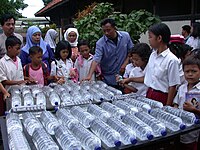
Photo from wikipedia
Abstract Washing is the traditional technique applied by the fresh produce industry to reduce the bacteria load. However, this method requires a high volume of water and a big challenge… Click to show full abstract
Abstract Washing is the traditional technique applied by the fresh produce industry to reduce the bacteria load. However, this method requires a high volume of water and a big challenge for the food industry is to minimize the use of water by for example recycling the water effluents. However, in order to avoid any possible cross-contamination, a disinfection step has to be carried out before the recirculation of the water. Non-thermal technologies (i.e. ultrasound (US) and ultraviolet-C (UV-C) light) were applied in this research for the disinfection of fresh produce water effluents. Lettuce wash water was recirculated (3 L/min) for 30 min in a closed system which consisted of an US device (26 kHz, 90 μm, 41.85 W/L) and an UV-C light system (1.64 kJ/m 2 ). Disinfection processes of (i) US, (ii) UV-C light and (iii) US combined with UV-C light were applied (US/UV-C), and aliquots were taken at different time intervals to analyze the microbial load, the colour and the suspended particles. The US/UV-C treatment was the most efficient process tested, regarding bacteria inactivation (3.57 ± 0.39 log CFU/mL), colour reduction (43.31%) and reduction of suspended particles (30%). Moreover, chemical oxygen demand (COD) was determined at the beginning and at the end of each disinfection process. The US/UV-C treatment was reported to cause the highest COD reduction (79%) in lettuce wash water. The energy requirements of US, UV and US + UV were found to be 0.107, 0.040, 0.114 kW/h, respectively while corresponding microbial reduction in relation to the energy spent was 4.15 × 10 −6 CFU/mL/J for US, 21.53 × 10 −6 CFU/mL/J for UV and 8.72 × 10 −6 CFU/mL/J for US/UV. These results prove that the combined effect of US and UV-C light may be a promising energy efficient disinfection technology for fresh cut wash water effluents when taking into account quality and safety parameters.
Journal Title: Journal of Food Engineering
Year Published: 2017
Link to full text (if available)
Share on Social Media: Sign Up to like & get
recommendations!